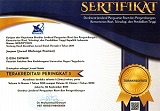THE ROLE OF NUTRITION AND HYDRATION TOWARD THE TENNIS BALL PLAYERS' PERFORMANCE
DOI:
https://doi.org/10.21831/jorpres.v6i1.10330Abstract
When practicing or matching, the tennis players will have many sweats. There will many sweats again, if they do sport exercise in a hot place. The sweats from the body can achieve a liter per hour. Many of tennis players, who do not know how many liquid that out from the body through the sweat when they play, practice or have a match. For men or women teenage players, they produce around one to two and a half liters sweats a day. However, for some professional players, that produce can get more until three and a half liters a day in a competition season.
If the body lost more than 2 % water from the total of body weight, it will cause dehydration (lack of the body's liquid) and can disturb their health. To prevent the dehydration, it is better for tennis players to drink before they feel thirsty. Drink water regularly with little electrolyte and carbohydrate are better to prevent the dehydration. It is suggested to drink juice from fresh fruits because of water and electrolyte in it which is needed to change the lost water and liquid from the body along practicing or having a match.
Keywords: nutrition, hydration, tennis ball athletes' performance
Downloads
How to Cite
Issue
Section
License
Authors who publish with this journal agree to the following terms:
- Authors retain copyright and grant the journal right of first publication with the work simultaneously licensed under a Creative Commons Attribution License that allows others to share the work with an acknowledgement of the work's authorship and initial publication in this journal.
- Authors are able to enter into separate, additional contractual arrangements for the non-exclusive distribution of the journal's published version of the work (e.g., post it to an institutional repository or publish it in a book), with an acknowledgement of its initial publication in this journal.
- Authors are permitted and encouraged to post their work online (e.g., in institutional repositories or on their website) prior to and during the submission process, as it can lead to productive exchanges, as well as earlier and greater citation of published work (See The Effect of Open Access).




